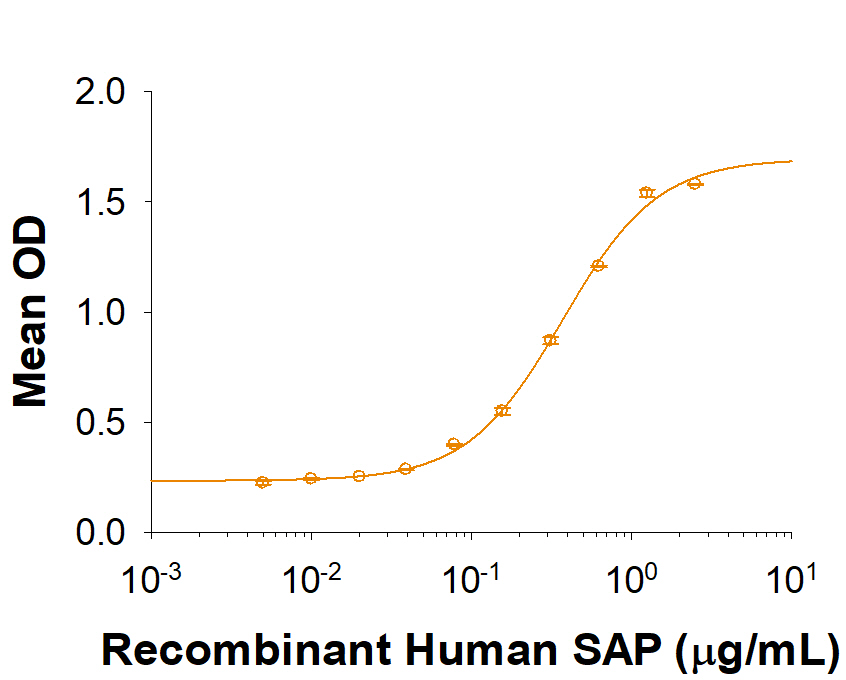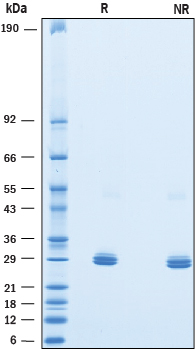Recombinant Human Pentraxin 2/SAP His-tag Protein, CF
Recombinant Human Pentraxin 2/SAP His-tag Protein, CF Summary
Product Specifications
His20-Val223, with a C-terminal 10-His tag
Analysis
Product Datasheets
Carrier Free
CF stands for Carrier Free (CF). We typically add Bovine Serum Albumin (BSA) as a carrier protein to our recombinant proteins. Adding a carrier protein enhances protein stability, increases shelf-life, and allows the recombinant protein to be stored at a more dilute concentration. The carrier free version does not contain BSA.
In general, we advise purchasing the recombinant protein with BSA for use in cell or tissue culture, or as an ELISA standard. In contrast, the carrier free protein is recommended for applications, in which the presence of BSA could interfere.
1948-SAB
| Formulation | Lyophilized from a 0.2 μm filtered solution in MOPS, NaCl and CaCl2 with Trehalose. |
| Reconstitution | Reconstitute at 250 μg/mL in water. |
| Shipping | The product is shipped with polar packs. Upon receipt, store it immediately at the temperature recommended below. |
| Stability & Storage: | Use a manual defrost freezer and avoid repeated freeze-thaw cycles.
|
Scientific Data
 View Larger
View Larger
When Recombinant Human Fc gamma RIIA/CD32a (R167) (Catalog # 1330-CD) is immobilized at 2 µg/mL, 100 µL/well, Recombinant Human SAP binds with an ED50 of 0.175-1 µg/mL.
 View Larger
View Larger
2 μg/lane of Recombinant Human Pentraxin 2/SAP was resolved with SDS-PAGE under reducing (R) and non-reducing (NR) conditions and visualized by Coomassie® Blue staining, showing bands at 27-33 kDa.
Reconstitution Calculator
Background: Pentraxin 2/SAP
Pentraxin 2 (PTX2), also known as Serum Amyoid P Component (SAP), is a secreted serum glycoprotein that is a universal non-fibrillar component of amyloid deposits. These extracellular deposits of insoluble protein fibrils are the result of protein misfolding and can lead to tissue damage and disease (1, 2). PTX2 belongs to the pentaxin superfamily, whose members have the characteristic pentagonal discoid arrangement of five non-covalently bound subunits. Pentaxins bind to a variety of molecules in a calcium-dependent lectin-like manner through a pattern-recognition-binding site (1, 4, 5). Two subfamilies of pentaxins, the classical or short pentaxin subfamily that includes the serum C-reactive protein (CRP) and PTX2, and the fusion or long pentaxin subfamily whose members contain pentaxin-related
carboxyl-terminal halves, are known (1).
PTX2 and CRP share approximately 50% amino acid sequence identity (2, 5). They are produced and secreted by liver hepatocytes and circulates in plasma. Mouse PTX2 is a major acute-phase protein whose plasma concentrations increase dramatically during an acute phase response (2). In human where CRP is the major
acute-phase protein, the plasma concentration of human PTX2 remains relatively constant in response to tissue-damage (2, 5). The gene for PTX2 has been localized to human chromosome 1 where it is closely linked to the gene for CRP.
PTX2 associates ubiquitously with all amyloid deposits that are implicated in a diverse range of diseases including Alzheimer’s and prion diseases, type 2 diabetes and various systemic amyloidoses (3, 6, 7). As a non-fibrillar component, PTX2 regulates the solubility of amyloid fibrils and protects them from degradation by proteolytic enzymes and phagocytic cells. In addition to its role in the pathogenesis of amyloidoses, PTX2 also has an important physiological function in innate immunity (8). It is an opsonin that interacts with all three types of human Fc gamma receptors that mediate phagocytosis by human polymorphonuclear leukocytes. It has been proposed that PTX2 may function as an opsonin for a variety of ligands including autoantigens, apoptotic cells, chromatin, DNA, and micro-organisms.
- Goodman, A. et al. (1996) Cytokine Growth Factor Rev. 7:191.
- Steel, D. and A. Whitehead (1994) Immunol. Today 15:81.
- Hirschfield, G.M. and P.N. Hawkins (2003) Int. J. Biochem. Cell Biol. 35:1608.
- Emsley, J. et al. (1994) Nature 367:338.
- Mantzouranis, E. et al. (1985) J. Biol. Chem. 260:7752.
- Botto, M. et al. (1997) Nature Medicine 3:855.
- Pepys, M. et al. (2002) Nature 417:254.
- Bharadwaj, D. et al. (2001) J. Immunol. 166:6735.
Citations for Recombinant Human Pentraxin 2/SAP His-tag Protein, CF
R&D Systems personnel manually curate a database that contains references using R&D Systems products. The data collected includes not only links to publications in PubMed, but also provides information about sample types, species, and experimental conditions.
4
Citations: Showing 1 - 4
Filter your results:
Filter by:
-
SAP deficiency aggravates periodontitis possibly via C5a-C5aR signaling-mediated defective macrophage phagocytosis of Porphyromonas gingivalis
Authors: L Wang, D Liang, Y Huang, Y Chen, X Yang, Z Huang, Y Jiang, H Su, L Wang, JL Pathak, L Ge
Journal of advanced research, 2022-10-12;0(0):.
Species: Human
Sample Types: Whole Cells
Applications: Bioassay -
Pentraxin-2 suppresses c-Jun/AP-1 signaling to inhibit progressive fibrotic disease
JCI Insight, 2016-12-08;1(20):e87446.
Species: Human
Sample Types: Whole Cells
Applications: Bioassay -
Three pentraxins C-reactive protein, serum amyloid p component and pentraxin 3 mediate complement activation using Collectin CL-P1
Authors: Nobutaka Wakamiya
Biochim. Biophys. Acta, 2016-11-15;0(0):.
Applications: Bioassay -
Fc receptor engagement mediates differentiation of cardiac fibroblast precursor cells.
Authors: Haudek SB, Trial J, Xia Y, Gupta D, Pilling D, Entman ML
Proc. Natl. Acad. Sci. U.S.A., 2008-07-15;105(29):10179-84.
Species: Human
Sample Types: Whole Cells
Applications: Bioassay
FAQs
No product specific FAQs exist for this product, however you may
View all Proteins and Enzyme FAQsReviews for Recombinant Human Pentraxin 2/SAP His-tag Protein, CF
There are currently no reviews for this product. Be the first to review Recombinant Human Pentraxin 2/SAP His-tag Protein, CF and earn rewards!
Have you used Recombinant Human Pentraxin 2/SAP His-tag Protein, CF?
Submit a review and receive an Amazon gift card.
$25/€18/£15/$25CAN/¥75 Yuan/¥2500 Yen for a review with an image
$10/€7/£6/$10 CAD/¥70 Yuan/¥1110 Yen for a review without an image
